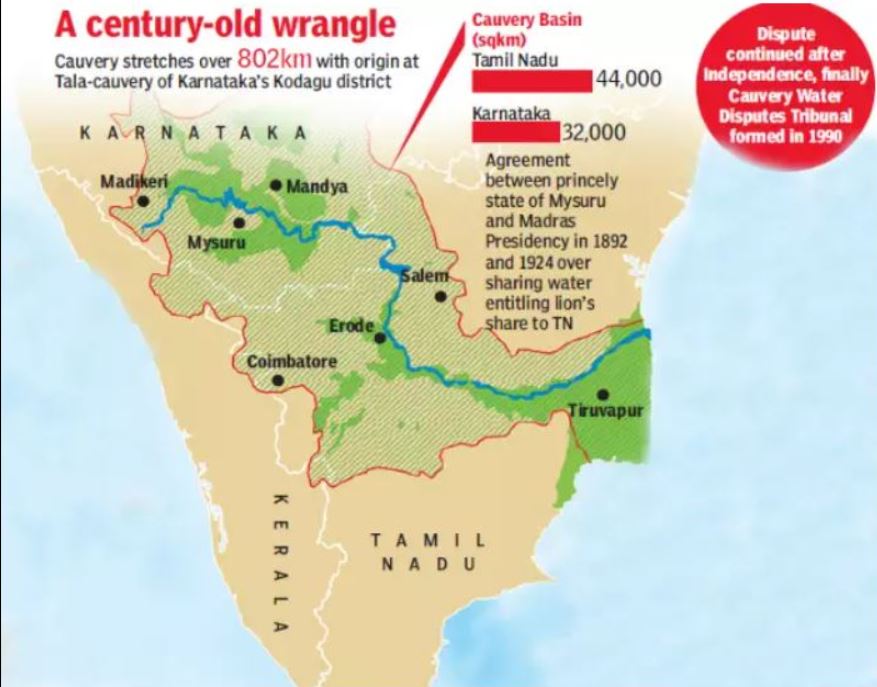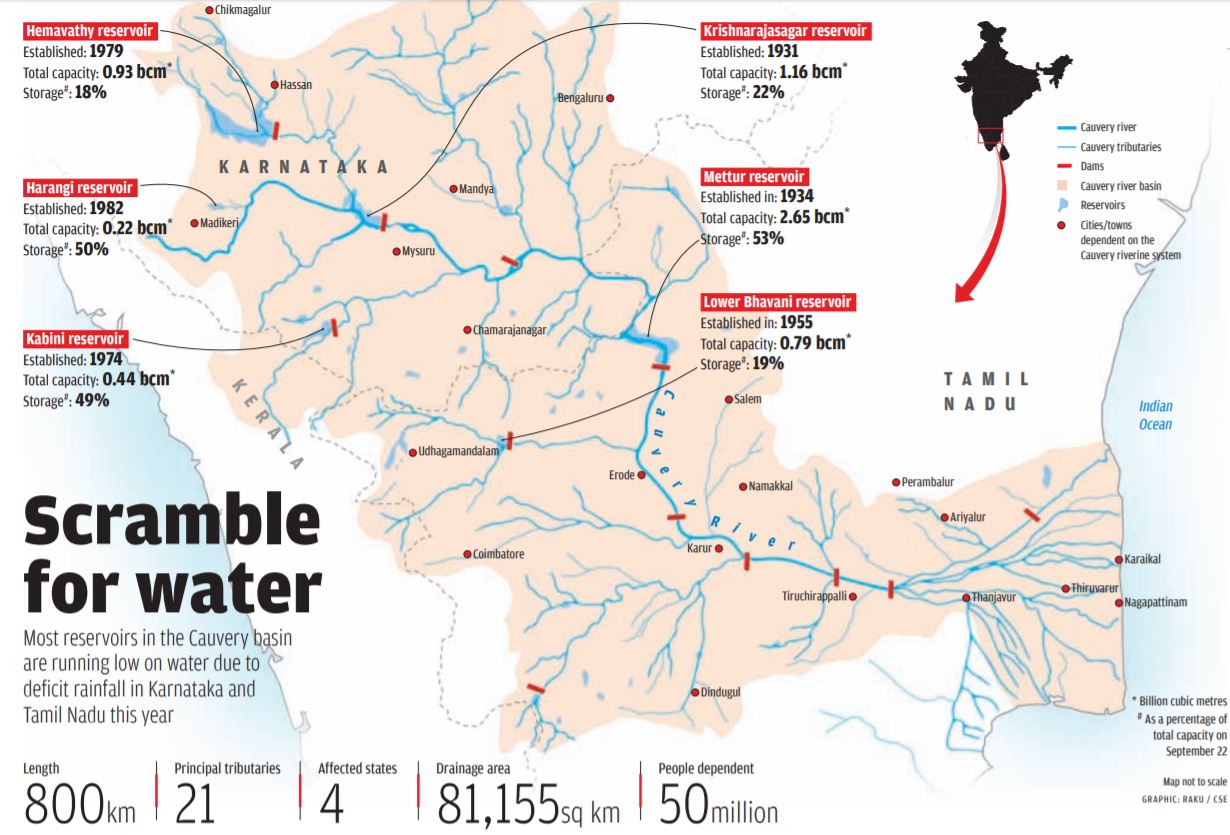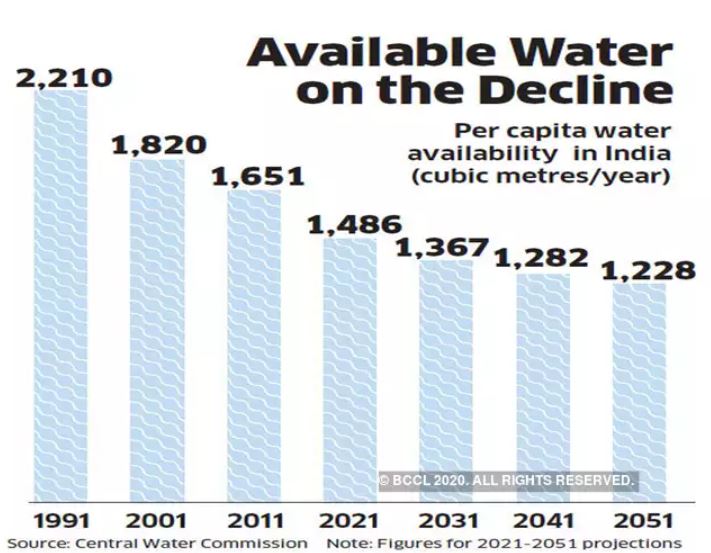Cauvery River Water Dispute
2020 MAY 7
Mains >
Geography > Resource geography > Resource geography

IN NEWS:
- The Union government’s decision to bring the Cauvery Water Management Authority (CWMA) under the Ministry of Jal Shakti has evoked stiff opposition from Tamil Nadu farmers’ organisations in the Cauvery delta region.
CAUVERY RIVER:
- Cauvery River (also spelt as ‘Kaveri’), known as ‘Ponni’ in Tamil, rises at Talakaveri on the Brahmagiri range in Kodagu district of Karnataka.
- It flows for about 800 km, through Karnataka and Tamil Nadu, before its outfall into the Bay of Bengal. Its basin is spread across Tamil Nadu, Kerala, Karnataka and the Union Territory of Pondicherry.
- The important tributaries joining the Cauvery are Harangi, Hemavati, Kabini, Suvarnavathi and Bhavani.
- Unlike other South Indian rivers, the Cauvery is perennial, as it receives rainfall from both advancing and retreating monsoons. Because of the river’s bountiful nature, the Cauvery delta is one of the most fertile regions in India.
- From antiquity to the present era, the river has been the lifeline of ancient kingdoms and cities of South India. Even today, it has a predominant cultural and spiritual significance.

HISTORY OF THE DISPUTE:
- The legal dispute over the waters of the Cauvery began in 1892 between the Madras Presidency under the British Raj and the princely state of Mysore.
- In 1910, the two states began conceptualizing the idea of constructing reservoirs in the river. As the two sides could not come to terms, the British presided over the issue of water sharing and in 1924, a 50-year agreement was signed.
- Between 1960 and late 1980s, Karnataka built four dams on Cauvery. Tamil Nadu, the lower riparian state, argued that this put them in a precarious situation and approached the Supreme Court.
- The SC directed the Centre to form a tribunal which would decide on the distribution of water between the two states. The Cauvery Water Disputes Tribunal (CWDT) was formed, but its verdict was not well received in both the states.
- In 1998, the Cauvery River Authority (CRA) was formed and was tasked with implementing the interim order of the CWDT. The CRA comprised of the Prime Minister as the Chairperson and the Chief Ministers of the four states as its members.
- In 2013, the Centre notified the final award of the CWDT, on the direction of the Supreme Court. Tamil Nadu moved to the Supreme Court, seeking directions to the water ministry for constitution of the Cauvery Management Board.
- In 2016, Tamil Nadu filed petition in the Supreme Court, seeking direction to Karnataka to release water to Tamil Nadu. The Court directed the release of water, which the Karnataka government initially did not oblige and filed for a review.
- In 2018, Court pronounced its verdict. It also mandated to formally constitute the Kavery river management board by the union government for implementing the tribunal award and its verdict.
CAUVERY WATER MANAGEMENT AUTHORITY (CWMA):
- The main mandate of the CWMA is to secure implementation and compliance of the Supreme Court’s order in relation to storage, apportionment, regulation and control of Cauvery waters.
- It will also advise the states to take suitable measures to improve water use efficiency, by promoting the use of micro-irrigation, change in cropping patterns, improved farm practices and development of command areas.
- The authority comprises of a chairman, a secretary and eight members. Out of the eight members, two will be full time and two will be part time members from Centre’s side. The remaining four will be part time members from states.
WHY THE DISPUTE CONTINUES:
- Variation in water levels: In the recent years, Cauvery has been experiencing frequent flood-drought cycles owing to variable rainfall, rampant pollution and excessive groundwater extraction. Hence, very often, there is not enough water in the river to fulfill the court’s verdict.

- Idealistic and outdate calculations: The Supreme Court’s verdict on the dispute rests on favourable conditions-that is, sufficient rainfall, steady flow and other presumptive calculations. However, in reality, such calculations rarely hold true. Also, since the 1970s, no calculations on the actual water flow in the Cauvery or her tributaries has been made. Decisions are made based on presumptions of data from fifty years ago.
- Large dependent population: The river is the lifeline for both the states. In Karnataka, major cities such as Bengaluru, Mysuru and Mandya depend on the Cauvery for drinking water. In Tamil Nadu, at least 1.7 crore people in the state-more than 20% of its population-in 19 districts are served by water from the Cauvery.
- Inefficient water use: Cauvery’s contribution to the food security of Tamil Nadu and to the nation is critical. However, irrigation in the basin is extremely inefficient, using water-intensive crops such as Samba and hence, productivity per unit of water used is low.
- Hydro politics: Water is an emotional issue for most part of the country. Political parties have leveraged them for mobilizing people. Hence, disputes states cannot seem to settle for less water from a river than it claims as its rightful share.
- Judicial delays: The adjudication by tribunals involves long-drawn adversarial litigations causing chronic delays. Also, even though the tribunal verdicts are final and binding on the parties, States challenge them on various grounds, which further delays dispute resolution.
- New climatic realities: New anthropogenic factors clubbed with climatic aberrations has set the tone for an impending water crisis. Hence, the tussle over existing water is only going to rise in the future.

THE INTER-STATE RIVER WATER DISPUTES (AMENDMENT) BILL, 2019:
- The bill provides for the adjudication of disputes relating to waters of inter-state rivers and river valleys. It amends the Inter-State River Water Disputes Act, 1956.
- Disputes Resolution Committee (DRC): Under the Bill, when a state puts in a request regarding any water dispute, the central government will set up a DRC to resolve the dispute amicably.
- The DRC will comprise of a Chairperson, and experts with at least 15 years of experience in relevant sectors, and one member from each state (at Joint Secretary level), who are party to the dispute, all to be nominated by the concerned state government.
- The DRC will seek to resolve the dispute through negotiations, within one year (extendable by six months), and submit its report to the central government.
- If a dispute cannot be settled by the DRC, the central government will refer it to the Inter-State River Water Disputes Tribunal.
- Tribunal: The central government will set up the Tribunal for the adjudication of water disputes.
- This Tribunal can have multiple benches. All existing Tribunals will be dissolved, and the water disputes pending adjudication before such existing Tribunals will be transferred to the new Tribunal.
- The Tribunal will consist of a Chairperson, Vice-Chairperson, three judicial members, and three expert members, to be appointed by the central government on the recommendation of a Selection Committee.
- Each Tribunal Bench will consist of a Chairperson or Vice-Chairperson, a judicial member, and an expert member.
- The central government may also appoint two experts serving in the Central Water Engineering Service as assessors to advise the Bench in its proceedings.
- Time frames: Under the Bill, the proposed Tribunal must give its decision on the dispute within two years, which may be extended by another year.
- The decision of the Bench of the Tribunal will be final and binding on the parties involved in the dispute.
- Data bank: Under the 1956 Act, the central government maintains a data bank and information system at the national level for each river basin. The Bill provides that the central government will appoint or authorize an agency to maintain such data bank.
WAY FORWARD:
- By 2050, it is expected that India, as a whole, could be categorised as a 'water scarce' country when measured in terms of per capita annual availability of water. Collaborative solutions, rather than hostility; cooperation, rather than conflict is the way out.
- Legal recourse to resolve every water-sharing dispute has its limitations. The need of the hour is instituting some innovative mechanisms.
- The solutions, to begin with, should include steps for conserving water in various sectors such as disincentivizing and discouraging unsustainable cropping patterns while incentivizing sustainable cropping patterns and crop diversification.
- Groundwater depletion should be arrested through suitable recharging. For this, rainwater harvesting and groundwater management should be made mandatory part of building codes.
- The states should adopt a mechanism for exchange of data and information on a regular basis. There has to be a continuous dialogue among stakeholders on the various aspects of water-sharing. A permanent forum should be constituted for this purpose.
- Conflicts over water are preventable, provided the communities involved become responsible water managers. Hence, Grassroot democratic institutions should be made active part of water conservation and management policies in India.
GLOBAL EXAMPLES:
- The Good Water Neighbors Project, set up in 2001, is an example of how political differences can be ironed out by bilateral cooperation. It brought together Israelis, Jordanians, and Palestinians to meet a common objective: protecting shared water resources. The project raised awareness of shared water problems of these communities, educated the youth and took help of both adult residents and municipal staff to create dialogue and cooperation on sustainable water management.
- The Nile Basin Initiative, an intergovernmental partnership of 10 Nile basin countries was established in February 1999. It works towards ensuring cooperation and joint action between the riparian countries. This initiative provided a forum for consultation and coordination among the basin states for sustainable management of Nile Basin water. The objective of the initiative went far beyond just securing water, but developing the Nile Basin water resources in an equitable way to ensure prosperity and peace in the region.
Source: Down To Earth
PRACTICE QUESTION:
Q. Legal recourse to resolving water-sharing disputes has its limitations. Discuss with emphasis on the Cauvery river water dispute?